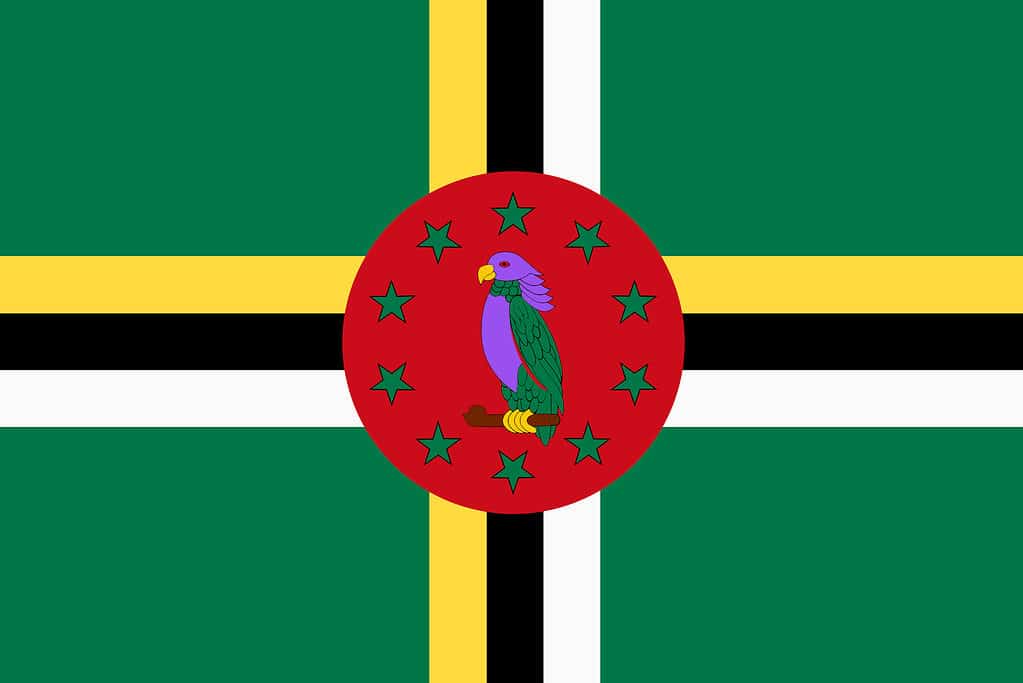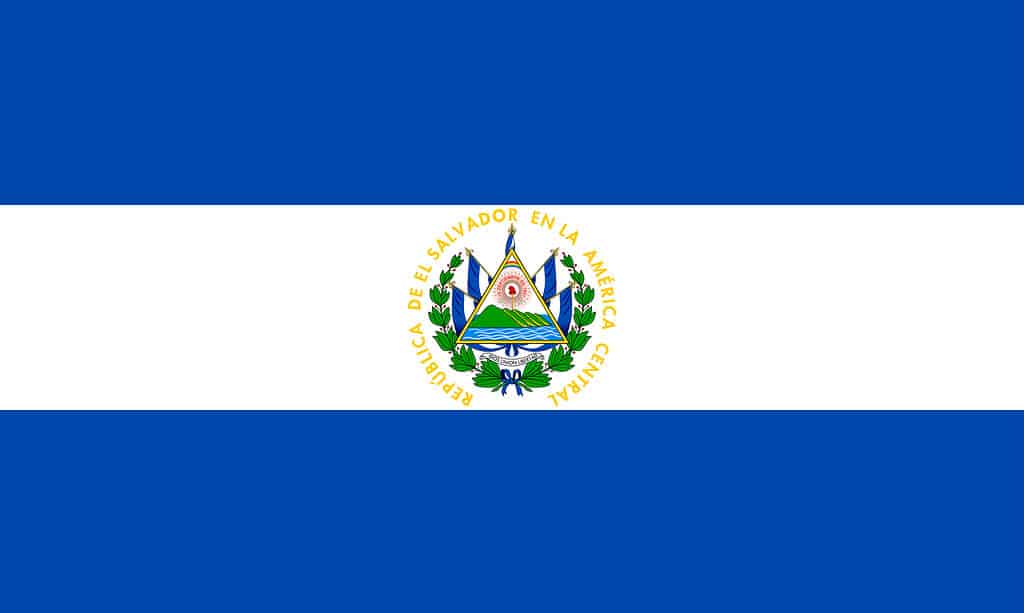The color purple is one of the rarest colors in all of vexillology (the study of flags), but that doesn’t mean it isn’t somewhere on a flag! In fact, three national flags utilize the color purple within their designs, all of which we will look at today. Let’s get started!
The Three National Flags With the Color Purple
Currently, only three national flags in the world use the color purple: Dominica, El Salvador, and Nicaragua. Additionally, the co-official national flag of Bolivia (known as the Wiphala) includes purple within it, although it isn’t a standalone national flag. Let’s take a look at all three national flags with purple, plus a quick look at the co-official national flag, the Wiphala.
Dominica

The flag of Dominica is a vibrant and distinctive symbol of the Caribbean island nation.
©iStock.com/Nigel Stripe
Dominica is a small island country located in the Caribbean, not to be confused with the Dominican Republic. The flag of Dominica is a vibrant and distinctive symbol of the Caribbean island nation. It was officially adopted on November 3, 1978, with a few small changes made in 1981, 1988, and 1990. The original design of the flag was created by playwright Alwin Bully in the early months of 1978 when Dominica was getting things ready before it officially declared its independence and became its own nation.
The flag of Dominica features a green field with a centered cross of three vertical bands: yellow, black, and white, and three horizontal bands: yellow, black, and white. At the center of the cross is a red disk containing a purple Sisserou parrot, which is the national bird of Dominica and an endemic and endangered species to the island. The parrot is surrounded by ten green, five-pointed stars, representing Dominica’s ten parishes. The colored cross symbolizes the trinity (within Christianity), with its three colors representing the indigenous people, the fertile soil, and the pure water on the island.
El Salvador

The flag of El Salvador features a blue-white-blue horizontal triband with the coat of arms in the middle.
©iStock.com/Juan Ignacio Rodríguez Moronta
El Salvador is another of the countries to include purple on their flag, even though it’s through the use of a rainbow. The design of the flag features a blue-white-blue horizontal triband with the coat of arms in the middle. The triple band is representative of the flag of the Greater Republic of Central America, as well as an earlier flag of El Salvador from 1875.
The coat of arms is where the purple can be seen. The design was adopted in 1912 and features a yellow triangle border with green volcanos (Soberbios Volcanes), an ocean, a Phrygian cap on a golden staff (a symbol of liberty), and a rainbow arch. The rainbow arch contains purple, with the arch representing a well-known biblical symbol of peace (a pact between God and Noah) from the Book of Genesis after the flood. It stands for God’s covenant with all living creatures to never again destroy life on Earth. The coat of arms has additional imagery and symbolism, including five additional flags, indigenous war spears, a laurel wreath, and important dates.
Nicaragua

The flag of Nicaragua features a blue-white-blue horizontal triband with the coat of arms in the middle.
©iStock.com/Juan Ignacio Rodríguez Moronta
Nicaragua, like El Salvador, has purple on its flag via a rainbow arch in its coat of arms. The flag of Nicaragua features a blue-white-blue horizontal triband with the coat of arms centered in the middle, exactly like El Salvador. This triband design is common throughout Central America and is representative of the flag of the Greater Republic of Central America.
In the middle of the white band on the flag is the Nicaraguan Coat of Arms. The coat of arms features a triangle border containing five green mountains, a Phrygian cap with a sunburst baby blue sky, a dark blue ocean, and a rainbow arch.
Co-National Flag of Bolivia (known as the Wiphala)

The Wiphala is a symbol of indigenous unity and pride.
©iStock.com/Amauta Fotografia
Aside from the three national flags with purple, the co-national flag of Bolivia also includes purple. This flag is known as the Wiphala.
The Wiphala is a square emblem commonly used as a flag to represent some native peoples of the Andes, including those in Peru, Bolivia, Chile, Ecuador, northwestern Argentina, and southern Colombia. It has seven colors, each representing the colors of the rainbow. The colors of the Wiphala have specific meanings: red represents the earth and the Andean mean, orange represents society and culture, yellow represents energy and strength, white represents time and change, green represents natural resources and wealth, blue represents the cosmos, and violet represents Andean government and self-determination.
The Wiphala is a symbol of indigenous unity and pride, and it is often displayed alongside the national flags of the countries where the indigenous peoples live. It has been recognized as an official flag in some countries, such as Bolivia.
Up Next:
- The Flag of Peru: History, Meaning, and Symbolism
- The British Flag: History, Meaning, and Symbolism
- The Flag of Brazil: History, Meaning, and Symbolism
The photo featured at the top of this post is © iStock.com/rarrarorro
Thank you for reading! Have some feedback for us? Contact the AZ Animals editorial team.






